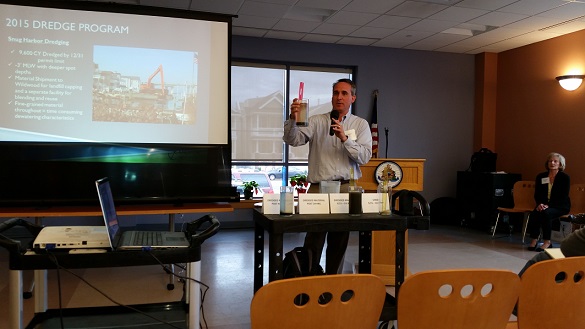By Donald Wittkowski
Ocean City’s lagoons are choked with 1 million cubic yards of muddy silt – the equivalent of 15 football stadiums filled with muck and mire.
Hoping to finally clean out this messy, soup-like material, the city will embark on a full-scale dredging program that promises to unclog the shallow lagoons and harbors along the back bays for generations to come.
Mayor Jay Gillian and representatives of the city’s dredging consultant told a town hall meeting Saturday attended by about 100 residents that the work will finally begin in earnest this year.
However, it will be extremely expensive. The city has proposed spending $20 million on dredging as part of its five-year, $98.5 million capital plan. But the mayor has estimated it could cost as much as $80 million to remove the entire 1 million cubic yards of mud and silt.
“We’re talking about a lot of money,” Gillian said, noting that the city will be looking for financial aid from the state and federal governments to help pay for the dredging.
The 1 million cubic yards of sediment is nearly double the previous estimates. The city is learning the full extent of the problem now that its dredging consultant, ACT Engineering, has conducted the first comprehensive survey of the lagoons, harbors and coves.
“To find out that we have over 1 million cubic yards to get rid of is unbelievable,” Gillian said.
In order to begin unclogging the lagoons, the city will also have to clear out a disposal site where the dredge spoils are stored temporarily before they are hauled off by trucks to a Wildwood landfill.
Known as Site 83, the disposal area near the 34th Street bridge can hold 300,000 cubic yards of dredge material. Construction has begun on a temporary road that will allow more trucks to serve the disposal site, speeding up the removal of dredge spoils to the Wildwood landfill.
Eric Rosina, project manager for ACT Engineering, said the emptying of Site 83 remains the top priority this year for the dredging program. As Site 83 is cleared out, it will free up more space for dredge spoils, which in turn will allow more lagoons to be deepened.
ACT Engineering is also exploring the possibility of using some of the dredge materials to help restore eroded wetlands, creating even more shoreline protection for Ocean City during coastal storms. State and federal environmental agencies would have to approve the wetlands restoration plan.
Rosina said two lagoons, Snug Harbor and Glen Cove, are scheduled to be dredged this year. Bay Bridge, at the foot of the Route 52 causeway, Carnival Bayou Lagoon, between 16th and 17th streets, and South Harbor, between Tennessee Avenue and Spruce Road, are considered possible dredging sites this year.
Snug Harbor, between Eighth and Ninth streets, was dredged last year, but the city’s contractor did not finish the job. Work is scheduled to resume in September to complete the dredging of Snug Harbor, which is so shallow that boats are trapped in their slips at low tide.

Glen Cove, between 10th and 11th streets, also has boats lying in the muddy bottom at low tide.
Although the city will clear out lagoons and harbors, it will be up to individual property owners to dredge their boat slips at their own expense. Gillian explained that the city simply cannot assume the liability – or cost – to dredge private slips.
Pressed by Ocean City residents during the town hall meeting for an estimate on how much it will cost them, Rosina said boat owners in Avalon paid about $14,000 to have their slips dredged. But he was unsure whether Ocean City boat owners would have to spend that much.
Rosina assured residents that ACT Engineering would be available to guide them through the planning and contracting phases of their dredging projects.
“We are here. We are going to work with you,” he said.
Gillian and ACT officials acknowledged that the city is finally catching up for years of delays in dredging the lagoons. ACT’s contract includes developing short-term plans for immediately addressing some of the problems and a longer-term strategy for “generations to come,” said Carol Beske, the company’s project principal.
Ocean City resident Marty Whalen, whose Walnut Road home overlooks Sunny Harbor, said he was forced to sell his boat recently because he could not get it out of the clogged lagoon.
“It just got to the point where I was locked in the lagoon for seven and a half hours at low tide,” he said.
Whalen lamented that Sunny Harbor has taken on a deserted look because other boat owners are mooring their vessels elsewhere.
“In my lagoon, we once had six to eight sport-fishing boats. Now there’s only one,” he said.







